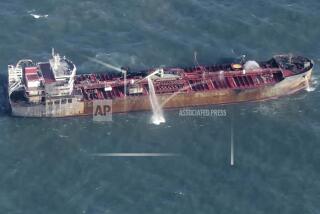110 Die in Ferry Blaze; Captain Calls It Arson : Tragedy: Rescuers begin grisly search of the Danish vessel at a Swedish port. Another 36 people are missing.
- Share via
LONDON — Police and firefighters late Saturday launched what was expected to be a grisly all-night search through the still-smoking hull of a North Sea ferry, looking for the bodies of victims who died in a possible arson attack on the ship during a voyage from Norway to Denmark.
Firefighters reported finding at least 110 bodies as the stricken Danish-operated Scandinavian Star was towed from a point about 30 miles from the mouth of the Oslo Fiord to Lysekil, a small port on the west coast of Sweden. Another 36 people are missing and believed dead in one of Europe’s worst ferry disasters since World War II.
“There are still rooms in the boat which have not been investigated, and people also might be lost at sea,” Lysekil Police Chief Roald Onsoe told a news conference Saturday night. “There is no more life on board.”
Earlier, an international air and sea rescue involving a score of ships and at least seven helicopters managed to carry a reported 321 other ferry passengers and crew members to safety in Norway, Sweden and Denmark.
A spokesperson for VR-DANO Line, the ferry operators, quoted Scandinavian Star Captain Hugo Larsen as saying that piles of clothes had been used to set three separate fires outside cabins on the vessel, which was on a regularly scheduled overnight run from Oslo to Frederikshavn, Denmark.
Scandinavian police were apparently taking the report seriously, though there was no immediate indication of what the motive for arson might have been.
According to Larsen’s account, crew members were able to extinguish two of the fires, but the third, on a different deck, raged out of control.
The Scandinavian Star left Oslo at about 11 p.m. local time Friday, 3 1/2 hours behind schedule, and first radioed a call for help at 2:30 a.m. Saturday, said Lars Kalland, liaison officer for the Maritime Rescue & Coordination Center of the Swedish Board of Navigation in Goteborg.
For hours after the tragedy began, sea rescue services were incorrectly reporting that all the passengers had been evacuated from the ship.
Most passengers were asleep in their cabins when the fire started. A crew of 21 firefighters from Goteborg, who reached the stricken vessel near dawn, reported finding “children and grown-ups lying (dead) in their nightgowns,” said Anneka Braide, a spokeswoman for the Swedish city’s fire service, in a telephone interview.
The victims appeared to have died from smoke inhalation rather than burns, she added.
Survivors said they heard no fire alarm, and they complained that the ship’s crew knew little about safety procedures.
“I was asleep, and I woke up because I felt there was the smell of smoke,” said one woman interviewed on British Broadcasting Corp. television. “And when I looked into the corridor, it was full of smoke.” She said that crew members didn’t know how to start the engine on the lifeboat she was aboard.
A Soviet ship that picked up 44 survivors was among several craft that rescued passengers and took them to various Scandinavian ports.
Braide said that the tragedy might have been far worse had the unpredictable North Sea weather not been at its best. The water was calm and the sky blue as the still-burning ship was towed toward Lysekil.
“I think it’s among the most difficult operations you can face as a firefighter,” Braide commented, “because you have to go deep down into a ship, it’s dark, the staircases are narrow, it’s hot and it’s smoke-filled. And so it’s physically very dangerous and very difficult. And in this case, since there are so many deaths, it’s also very tough psychological work, that you face death everywhere.”
Firefighters tried “to use as little water as possible” in order not to further destabilize the already listing ferry and increase the danger that it would capsize, the Goteborg fire service spokeswoman added. The metal hull of the ship got so hot, she added, that firefighters would no sooner put out one blaze than another would flare.
The crippled ferry was finally towed into Lysekil at about 9 p.m. Saturday evening, more than 18 hours after first reporting trouble, said Kristina Allen, a spokeswoman at the special police incident room set up in the small port.
She said in a telephone interview that “hundreds” of workers were preparing to search the ship and remove the bodies of victims. “The plan is that they’re going to work through tonight,” she said.
Most of the approximately 400 passengers on the Scandinavian Star were reportedly Scandinavian tourists getting an early start on their Easter holiday. The crew, numbering about 100, was mostly Portuguese and Filipino.
The vessel carried about 100 automobiles and 14 trucks as well as passengers, said the maritime rescue center’s Kalland.
The Bahamian-registered ferry is owned by the Danish shipping company VR-DANO Line, the Associated Press reported. SeaEscape Ltd. of Miami sold the ship to VR-DANO last month, a SeaEscape spokeswoman said in a telephone interview from Miami.
AP reported that an engine room fire broke out aboard the Scandinavian Star in March, 1988, as the vessel sailed from Cozumel, Mexico, to Tampa, Fla. None of the 439 passengers on board at that time, most of them Americans, were injured.
More to Read
Sign up for Essential California
The most important California stories and recommendations in your inbox every morning.
You may occasionally receive promotional content from the Los Angeles Times.













